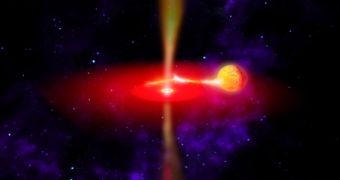In a paper published in last month's issue of the esteemed Astrophysical Journal Letters, experts propose that black holes can suffer from what they plastically refer to as indigestion. The phenomenon only occurs during prolonged sessions on accreting matter non-stop.
Astrophysicists say that black holes that accrete most mass are those located in binary systems and inside the agglomerated cores of massive galaxies. In the first case, black holes siphon mass from their companions without a care in the world.
In some cases, their companions may be normal stars, but in others they may accompanied by neutron stars or other less-common space bodies. But feasting for millions of years on end has the same effect on a black hole as eating a lot of food in a hurry has on humans – burping.
This was made obvious on the black hole bearing designation GX 339-4. While surveying it through the eyes of the NASA Wide-field Infrared Survey Explorer (WISE) telescope, experts found massive flares rising up from its usual jets at different intervals.
Surveys also indicate that the flare-ups last for only a few hours, during which time the jets appear three times brighter than usual. After this interval, the brightness subsides until the next occurrence.
This particular black hole is located only a few million miles away from a companions star, from which it draws significant amounts of mass at a constant pace. The tidal and gravitational interactions heat up the incoming gas to millions of degrees.
At the same time, the strong magnetic fields surrounding the black hole divert some of the material away from the event horizon, creating the jets that can normally be seen emanating from large black holes.
“GX 339-4 was caught with a particularly bright jet, with none of the other contaminating components. We were able to cleanly focus on the jet in isolation,” Japan Aerospace Exploration Agency (JAXA) expert Posahk Gandhi told Space.
“WISE looked at the full sky, allowing serendipitous discoveries to be made. Since black holes are highly variable, you have to catch them at the right time, and we got lucky with WISE,” he adds.
“WISE happened to catch this source in a state of heightened jet activity in March 2010, when other radio, X-ray, optical and ultraviolet telescopes were observing the same source intensively,” the investigator goes on to say.

 14 DAY TRIAL //
14 DAY TRIAL //